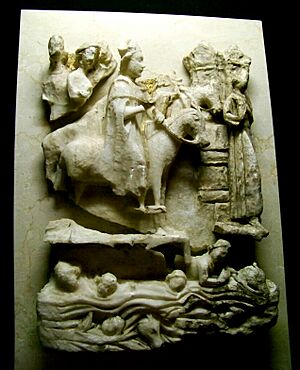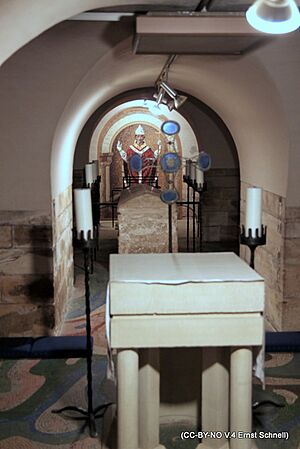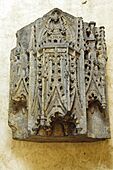William of York facts for kids
Quick facts for kids William |
|
|---|---|
| Archbishop of York | |
| Elected |
|
| Enthroned | 1141 |
| Reign ended |
|
| Predecessor |
|
| Successor |
|
| Other posts | Treasurer of York |
| Orders | |
| Consecration | 26 September 1143 |
| Personal details | |
| Born | Late 11th century |
| Died | 8 June 1154 York, Kingdom of England |
| Buried | York Minster |
| Parents | |
| Sainthood | |
| Feast day | 8 June |
| Venerated in | |
| Canonized | 18 March 1226 Rome by Pope Honorius III |
| Shrines | York Minster |
William of York (born in the late 1000s – died June 8, 1154) was an important English church leader. He served twice as the Archbishop of York. This was before and after another archbishop named Henry Murdac. Many believed William was related to King Stephen of England. The King helped him get elected as archbishop.
However, William faced strong opposition from a group of monks called the Cistercians. When a Cistercian became Pope Eugene III, William was removed from his position. Henry Murdac, a Cistercian, took his place. From 1147 to 1153, William worked hard to get his job back. He succeeded after both Murdac and Pope Eugene III passed away. William did not stay archbishop for long. He died soon after returning, possibly from poison. Miracles were reported at his tomb starting in 1177. He was made a saint in 1226.
Contents
William's Early Life
William was born in York. His full name was William fitzHerbert. His father, Herbert of Winchester, was a powerful official for King Henry I. Most people think his mother was Emma. She was believed to be the half-sister of King Stephen. New research suggests Emma might have been from a different family. William was born sometime before the 1090s. We do not know the exact date.
William held several important church jobs when he was young. He was a prebendary (a church official who received income from a cathedral) in Yorkshire. He also became the Treasurer of York. Later, he was made an archdeacon (a senior church official). His father's wealth and influence likely helped him get these roles. William served under Archbishop Thurstan of York. He even joined Thurstan in exile when Thurstan had a disagreement with King Henry I.
Problems with William's Election
In January 1141, William was chosen to be the Archbishop of York. Before him, the church leaders in York had picked someone else. But that choice was canceled because of a bribe. Then, another candidate was chosen, but the Pope did not approve him. Finally, in January 1141, William was selected.
However, many people opposed William's election. Monks from Cistercian monasteries in Yorkshire were against it. The Archbishop of Canterbury, Theobald of Bec, also refused to accept William. There were claims that William's election involved simony (buying church positions). There were also claims that King Stephen interfered too much. In 1143, Pope Innocent II said William could be archbishop. But only if he swore an oath that the claims were false. After William swore the oath, he was officially made archbishop on September 26, 1143.
First Time as Archbishop
As Archbishop, William made many church improvements. He became very popular with the people of York. But he still needed a pallium. This is a special woolen scarf that shows an archbishop's authority from the Pope. The Cistercians still strongly opposed him. They tried to stop him from getting the pallium.
William traveled to Rome to get it. But then, a Cistercian monk became Pope Eugene III in 1145. This was bad news for William. A famous Cistercian leader, Bernard of Clairvaux, used his influence against William. He sent many complaints to the new Pope. He claimed William was put in his job by powerful people. He also said William was treating Cistercian monasteries badly. In 1147, Pope Eugene III officially removed William from his position.
After William was removed, another election for Archbishop of York was held. Henry Murdac, a Cistercian abbot, was chosen. William then went to live in Winchester.
William's Return as Archbishop
King Stephen did not agree with William being removed. He also stopped Murdac from moving to York. Stephen wanted to use this situation to help his son, Eustace, become the next king.
After a few years, both Murdac and Pope Eugene III died. William traveled to Rome again. He asked the new Pope Anastasius IV to give him his job back. The Pope agreed! William was officially reappointed on December 20, 1153. On his way back to York, William crossed the Ouse Bridge. The bridge collapsed, but amazingly, no one was hurt.
Death and Becoming a Saint
William died on June 8, 1154. This was less than a month after he returned to York. Some people believed he was poisoned during a church service. One of William's assistants accused another church official of the murder. But the king died before a trial could happen.
William was buried in York Minster. Soon after his death, people reported miracles happening at his tomb. When his tomb was damaged in a fire, a sweet smell came from it. His body also did not decay or burn. Pope Honorius III ordered an investigation into these miracles. In 1226, William was made a saint in Rome.
Saint William's feast day is celebrated on June 8. This is the day he died. He is mainly honored in York. His iconography (pictures or symbols) often shows him crossing the River Ouse. Some pictures show him in a boat.
A church in Sheffield was dedicated to Saint William in 1932.
St William's College
St William's College is a building next to York Minster. It was named after Saint William. It was built between 1465 and 1467. It was a home for priests who prayed for the souls of others.
St William's Chapel
A chapel (a small church) dedicated to Saint William was built in York in the late 1100s. It was on the Ouse Bridge. It marked the miracle when the bridge collapsed but no one was hurt when William returned to York. The chapel was used until 1550. It was removed when the bridge was rebuilt between 1810 and 1818.
Saint William's Shrines
The first shrine for Saint William in York Minster was built around the 1220s. His stone coffin was buried in the floor. A shrine structure was built above it. This allowed people to touch the coffin lid. In 1284, William's body was moved to a new shrine. This new shrine was behind the main altar.
Later, a larger shrine was built in the Minster's main area around 1330. It was a tall stone structure with decorations. The latest and most important shrine was built near the Minster's High Altar in 1471-1472. It was made of dark marble. It had a large base where a reliquary (a container for holy relics) of William was placed. A wooden cover was placed over it.
- Shrines of St William
While not many large groups of pilgrims visited, some stained glass windows in the Minster show people praying at the shrines. William's stone coffin has a smooth top. This is probably from pilgrims touching it over many years.
In 1541, the Privy Council ordered all shrines in the area to be taken down. William's shrines were taken apart and buried. Over the years, pieces of the shrines were found in different places around York. William's coffin was found again in 1732 and 1968. His remains are now in a shrine in the crypt of York Minster. Some parts of the shrines are now in the Yorkshire Museum. This is the only example of a saint's shrine in a museum in England.






